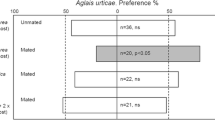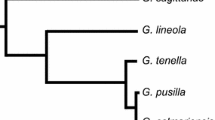Abstract
The predatory mite Phytoseiulus persimilis locates its prey, the two-spotted spider mite, by means of herbivore-induced plant volatiles. The olfactory response to this quantitatively and qualitatively variable source of information is particularly well documented. The mites perform this task with a peripheral olfactory system that consists of just five putative olfactory sensilla that reside in a dorsal field at the tip of their first pair of legs. The receptor cells innervate a glomerular olfactory lobe just ventral of the first pedal ganglion. We have made a 3D reconstruction of the caudal half of the olfactory lobe in adult females. The glomerular organization as well as the glomerular innervation appears conserved across different individuals. The adult females have, by approximation, a 1:1 ratio of olfactory receptor cells to olfactory glomeruli.


Similar content being viewed by others
References
Ache BW, Young JM (2005) Olfaction: diverse species, conserved principles. Neuron 48:417–430
Bolland HR, Gutierrez J, Flechtmann CHW (1998) World catalogue of the spider mite family. Brill, Leiden, The Netherlands
Davis RL (2004) Olfactory learning. Neuron 44:31–48
de Boer JG, Dicke M (2004) Experience with methyl salicylate affects behavioural responses of a predatory mite to blends of herbivore-induced plant volatiles. Entomol Exp Appl 110:181–189
de Boer JG, Posthumus MA, Dicke M (2004) Identification of volatiles that are used in discrimination between plants infested with prey or nonprey herbivores by a predatory mite. J Chem Ecol 30:2215–2230
de Boer JG, Snoeren TAL, Dicke M (2005) Predatory mites learn to discriminate between plant volatiles induced by prey and nonprey herbivores. Anim Behav 69:869–879
De Moraes CM, Lewis WJ, Pare PW, Alborn HT, Tumlinson JH (1998) Herbivore-infested plants selectively attract parasitoids. Nature 393:570–573
De Bruyne M, Dicke M, Tjallingii WF (1991) Receptor cell responses in the anterior tarsi of Phytoseiulus persimilis to volatile kairomone components. Exp Appl Acarol 13:53–58
Dicke M (1994) Local and systemic production of volatile herbivore-induced terpenoids–their role in plant-carnivore mutualism. J Plant Physiol 143:465–472
Dicke M, Sabelis MW (1988) How plants obtain predatory mites as bodyguards. Neth J Zool 38:148–165
Dicke M, Takabayashi J, Posthumus MA, Schuette C, Krips OE (1998) Plant-phytoseiid interactions mediated by herbivore-induced plant volatiles: variation in production of cues and in responses of predatory mites. Exp Appl Acarol 22:311–333
Dicke M, Van Beek TA, Posthumus MA, Ben Dom N, Van Bokhoven H, De Groot AE (1990) Isolation and identification of volatile kairomone that affects acarine predator-prey interactions–involvement of host plant in its production. J Chem Ecol 16:381–396
Drukker B, Bruin J, Jacobs G, Kroon A, Sabelis MW (2000) How predatory mites learn to cope with variability in volatile plant signals in the environment of their herbivorous prey. Exp Appl Acarol 24:881–895
Eigenbrode SD, Ding H, Shiel P, Berger PH (2002) Volatiles from potato plants infected with potato leafroll virus attract and arrest the virus vector, Myzus persicae (Homoptera: Aphididae). Proc R Soc Lond Ser B-Biol Sci 269:455–460
Eisthen HL (2002) Why are olfactory systems of different animals so similar? Brain Behav Evol 59:273–293
Fiala JC (2005) Reconstruct: a free editor for serial section microscopy. J Microsc Oxf 218:52–61
Galizia CG, Menzel R (2000) Odour perception in honeybees: coding information in glomerular patterns. Curr Opin Neurobiol 10:504–510
Goldman AL, van Naters WV, Lessing D, Warr CG, Carlson JR (2005) Coexpression of two functional odor receptors in one neuron. Neuron 45:661–666
Gouinguene SP, Turlings TCJ (2002) The effects of abiotic factors on induced volatile emissions in corn plants. Plant Physiol 129:1296–1307
Hildebrand JG, Shepherd GM (1997) Mechanisms of olfactory discrimination: converging evidence for common principles across phyla. Annu Rev Neurosci 20:595–631
Jackson GJ (1974) Chaetotaxy and setal morphology of the palps and first tarsi of Phytoseiulus persimilis a. -h (acarina: Phytoseiidae). Acarologia 16:583–594
Jagers op Akkerhuis G, Sabelis MW, Tjallingii WF (1985) Ultrastructure of chemical receptors on the pedipalps and first tarsi of Phytoseiulus persimilis. Exp Appl Acarol 1:235–251
Jimenez-Martinez ES, Bosque-Perez NA, Berger PH, Zemetra R, Ding HJ, Eigenbrode SD (2004) Volatile cues influence the response of Rhopalosiphum padi (Homoptera: Aphididae) to barley yellow dwarf virus-infected transgenic and untransformed wheat. Environ Entomol 33:1207–1216
Kant MR, Ament K, Sabelis MW, Haring MA, Schuurink RC (2004) Differential timing of spider mite-induced direct and indirect defenses in tomato plants. Plant Physiol 135:483–495
Kreher SA, Kwon JY, Carlson JR (2005) The molecular basis of odor coding in the Drosophila larva. Neuron 46:445–456
Krips OE, Willems PEL, Gols R, Posthumus MA, Dicke M (1999) The response of Phytoseiulus persimilis to spider mite-induced volatiles from gerbera: Influence of starvation and experience. J Chem Ecol 25:2623–2641
Laurent G (1999) A systems perspective on early olfactory coding. Science 286:723–728
Lessing D, Carlson JR (1999) Chemosensory behavior: the path from stimulus to response. Curr Opin Neurobiol 9:766–771
Meijerink J, Carlsson MA, Hansson BS (2003) Spatial representation of odorant structure in the moth antennal lobe: a study of structure-response relationships at low doses. J Comp Neurol 467:11–21
Mombaerts P, Wang F, Dulac C, Chao SK, Nemes A, Mendelsohn M, Edmondson J, Axel R (1996) Visualizing an olfactory sensory map. Cell 87:675–686
Mori K, Nagao H, Yoshihara Y (1999) The olfactory bulb: coding and processing of odor molecule information. Science 286:711–715
Pels B, Sabelis MW (1999) Local dynamics, overexploitation and predator dispersal in an acarine predator-prey system. Oikos 86:573–583
Ramaekers A, Magnenat E, Marin EC, Gendre N, Jefferis G, Luo LQ, Stocker RF (2005) Glomerular maps without cellular redundancy at successive levels of the Drosophila larval olfactory circuit. Curr Biol 15:982–992
Ressler KJ, Sullivan SL, Buck LB (1994) Information coding in the olfactory system–evidence for a stereotyped and highly organized epitope map in the olfactory-bulb. Cell 79:1245–1255
Rubin BD, Katz LC (1999) Optical imaging of odorant representations in the mammalian olfactory bulb. Neuron 23:499–511
Sabelis MW, Afman BP, Slim PJ (1984) Location of distant spider mite colonies by Phytoseiulus persimilis: localization and extraction of a kairomone. Acarology 4:431–440
Sabelis MW, Van der Baan HE (1983) Location of distant spider mite colonies by phytoseiid predators: demonstration of specific kairomones emitted by Tetranychus urticae and Panonychus ulmi. Exp Appl Acarol 33:303–314
Sabelis MW, Janssen A, Pallini A, Venzon M, Bruin J, Drukker B, Scutareanu P (1999) Behavioural responses of predatory and herbivorous arthropods to induced plant volatiles: from evolutionary ecology to agricultural applications (APS Press, The American Phytopathological Society: St. Paul, Minnesota.)
Sabelis MW, Takabayashi J, Janssen A, Kant MR, van Wijk M, Sznajder B, Aratchige N, Lesna I, Belliure B, Schuurink RC (2007) Ecology meets plant physiology: Herbivoreinduced plant responses and their indirect effects on arthropod communities. In: Ohgushi T, Craig TP, Price PW (eds) Ecological communities: Plant mediation in indirect interaction webs. Cambridge University Press, New York, USA, pp 188–217
Strausfeld NJ, Hansen L, Li YS, Gomez RS, Ito K (1998) Evolution, discovery, and interpretations of arthropod mushroom bodies. Learn Mem 5:11–37
Strausfeld NJ, Hildebrand JG (1999) Olfactory systems: common design, uncommon origins? Curr Opin Neurobiol 9:634–639
Takabayashi J, Dicke M (1992) Response of predatory mites with different rearing histories to volatiles of uninfested plants. Entomol Exp Appl 64:187–193
Takabayashi J, Sabelis MW, Janssen A, Shiojiri K, van Wijk M (2006) Can plants betray the presence of multiple herbivore species to predators and parasitoids? The role of learning in phytochemical information networks. Ecol Res 21:3–8
Thaler JS, Farag MA, Pare PW, Dicke M (2002) Jasmonate-deficient plants have reduced direct and indirect defences against herbivores. Ecol Lett 5:764–774
Uchida N, Takahashi YK, Tanifuji M, Mori K (2000) Odor maps in the mammalian olfactory bulb: domain organization and odorant structural features. Nat Neurosci 3:1035–1043
van den Boom CEM, Van Beek TA, Posthumus MA, De Groot AE, Dicke M (2004) Qualitative and quantitative variation among volatile profiles induced by Tetranychus urticae feeding on plants from various families. J Chem Ecol 30:69–89
van Wijk M, Wadman WJ, Sabelis MW (2007) Gross morphology of the central nervous system of a phytoseiid mite. Exp Appl Acarol (in press). doi: 10.1007/s10493-006-9039-9
Vosshall LB, Wong AM, Axel R (2000) An olfactory sensory map in the fly brain. Cell 102:147–159
Wachowiak M, Cohen LB (2001) Representation of odorants by receptor neuron input to the mouse olfactory bulb. Neuron 32:723–735
Wachowiak M, Denk W, Friedrich RW (2004) Organization of sensory input to the olfactory bulb glomerulus analyzed by two-photon calcium imaging. Proc Natl Acad Sci USA 101(24):9097–9102
Wilson DA, Stevenson RJ (2003) The fundamental role of memory in olfactory perception. Trends Neurosci 26:243–247
Author information
Authors and Affiliations
Corresponding author
Rights and permissions
About this article
Cite this article
van Wijk, M., Wadman, W.J. & Sabelis, M.W. Morphology of the olfactory system in the predatory mite Phytoseiulus Persimilis . Exp Appl Acarol 40, 217–229 (2006). https://doi.org/10.1007/s10493-006-9038-x
Received:
Accepted:
Published:
Issue Date:
DOI: https://doi.org/10.1007/s10493-006-9038-x




